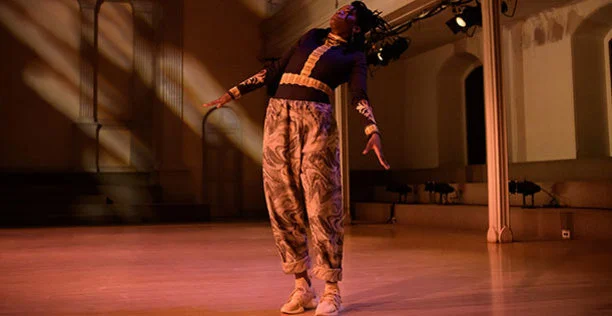In Conversation with Angie Pittman
By Nicole Kaiser, Summer 2019 Curatorial Intern
The “In Dialogue” series spotlights conversations between members of The Kitchen’s community about art and ideas.
Angie Pittman is a Bessie award-winning dance artist, maker, and educator whose work investigates how her body moves through ballad, groove, sparkle, spirit, spirituals, ancestry, vulnerability, and power. A longtime Kitchen friend, Pittman returns to our space on June 29 to perform in the final weekend of ASSEMBLY. Ahead of this performance, we spoke to her about her process of crafting multi-dimensional dance work and the ways inspiration from all media translate into movement.
I’m not a dancer myself, so I’m quite curious to know more about your process. How do you first begin to develop a routine? Does your process demand extensive memorization or do you find yourself moving freely, often improvising?
I think one of my strengths as a human and a dancer is the ability to hold many truths at once. My choreographic practice reflects this. It is a deeply improvisational practice that I learned from my mama and developed through my various dance trainings (grad school, social dance, liturgical dance). I develop scores around feelings or actions that I find important in the conversation of Black resistance. For example, I did a piece on leaning; leaning as an action that can be seen as defiance but also important in the resting process—we know Black people need the most rest. My improvisation practice includes making lists of music, books, and movies, doing video documentation, and then distilling essences of that into movement. In my choreography I am not remembering specific steps, but sensations, feelings, and shapes, inspired by the lists I make. Some of my favorite current examples are: “I Love You” by Dru Hill, “In the Upper Room” performed by Mahalia Jackson, Wesley Snipes’s portrayal of Blade, In The Wake by Christina Sharpe, and Maggot Brain by Funkadelic.
Your performances have been described as quiet, calm, and steady. Do you agree?
I would. I guess I would also say they are theatrical, reverent, and reminiscent of gazing out of a window.
The gaze of white strangers is always something that I think about. Being socialized and identifying as a Black woman, there is/was always a relationship to the gaze and consumption. I’ve been really into vampire folklore lately: blood-sucking, fear of extinction being related to how you eat/nourish yourself and how that’s related to white supremacy—the living dead. I use performance as a way to reconcile this dissonance and, of course, that’s always changing. I dance my guts.
In what ways have your experimental performances broken from your technical training? Where have you found yourself adhering to the skills you learned from your MFA program?
I like to think that everything I know about dance and performance I learned from my mama and church, and was supplemented by my experience in different university contexts. The training I received in grad school provided me with more tools and space to explore and excavate those relationships.
I am grateful to my mentors through all of those contexts.
Your prior work at the Kitchen— as part of Dance and Process and On Whiteness — were both fairly open invitations within a specific context/theme. How do you find working within the limitations of another conceptual project or space?
I think that in both of those contexts at The Kitchen, The Kitchen curatorial team’s frame was asking me to do work that I was already doing. Particularly with the On Whiteness series, I appreciated the institution’s commitment to implicating whiteness. Through their work with The Racial Imaginary Institute, they did important work around framing and acknowledging the institution’s structure and its complicity in perpetuating oppressive sources of power through whiteness. My work is centered around my experience, so I felt like I didn’t feel the need to do any extra labor to fit into this frame. I’m Black and therefore I can’t/shan’t/don’t want to be white, so providing a space for my work to live is conceptual enough. Because of this, I think these types of opportunities to share my work at The Kitchen are quite freeing.
Images: 1) Angie Pittman. Photo by Ian Douglas.

